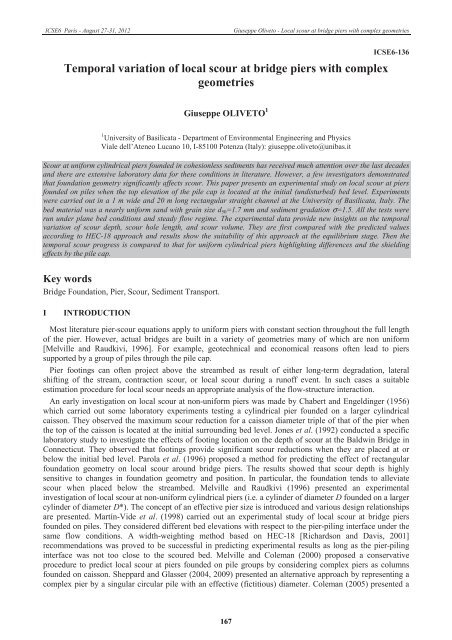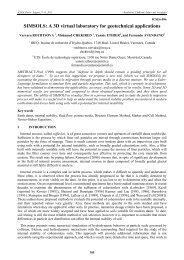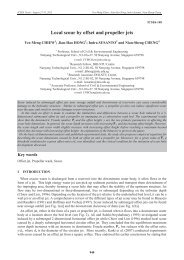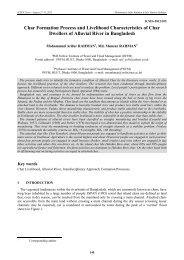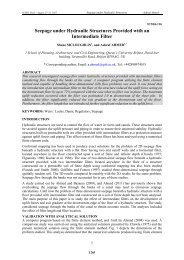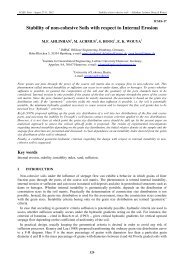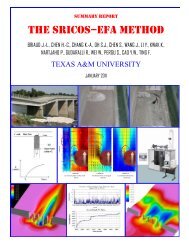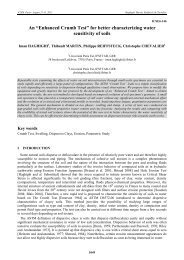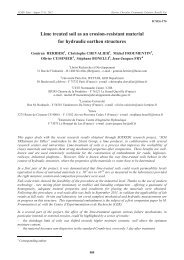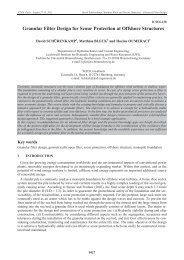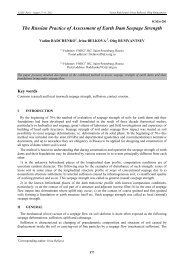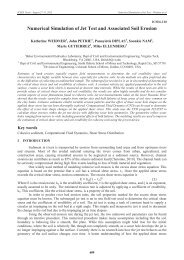Temporal Variation of Local Scour at Bridge Piers with Complex ...
Temporal Variation of Local Scour at Bridge Piers with Complex ...
Temporal Variation of Local Scour at Bridge Piers with Complex ...
You also want an ePaper? Increase the reach of your titles
YUMPU automatically turns print PDFs into web optimized ePapers that Google loves.
ICSE6 Paris - August 27-31, 2012Giuseppe Oliveto - <strong>Local</strong> scour <strong>at</strong> bridge piers <strong>with</strong> complex geometriesnew methodology to predict local scour depth <strong>at</strong> a complex pier for varying pile cap elev<strong>at</strong>ion. The effects <strong>of</strong>the upstream pile cap extension were also considered, noting such an extension acts to reduce scour byintercepting the pier downflow and protecting the bed from the pier-gener<strong>at</strong>ed horseshoe vortex. Ataie-Ashtiani et al. (2010) carried out 70 experiments considering a variety <strong>of</strong> configur<strong>at</strong>ion, including differentsizes and shapes <strong>of</strong> complex piers. They found th<strong>at</strong> the pile cap protects the bed from scour and postpone thebeginning <strong>of</strong> the scour development when it is loc<strong>at</strong>ed <strong>at</strong> the bed level. Moreover, in such a condition, ittakes a long time to achieve equilibrium conditions. The outcomes <strong>of</strong> an experimental study on local scour <strong>at</strong>a pile cap are provided by Amini et al. (2011). Experiments were conducted under clear-w<strong>at</strong>er regime andthe main variables considered were the pile cap dimension and its loc<strong>at</strong>ion rel<strong>at</strong>ive to the initial streambed.Based on the d<strong>at</strong>a collected and historical measurements a new predictive method is then proposed.However, the above studies mainly consider equilibrium scour conditions and focus on the maximum scourdepth or the scour depth <strong>at</strong> the front <strong>of</strong> the found<strong>at</strong>ion. Based on a number <strong>of</strong> recent labor<strong>at</strong>ory experiments,some <strong>of</strong> which <strong>of</strong> long dur<strong>at</strong>ion, this paper aims to provide some insights on the temporal and sp<strong>at</strong>ialevolution <strong>of</strong> the local bed morphology around piers founded on piles when the top elev<strong>at</strong>ion <strong>of</strong> the pile cap isflush <strong>with</strong> the undisturbed bed level. Differences <strong>with</strong> local scour <strong>at</strong> uniform cylindrical piers are alsoexamined.IIEXPERIMENTSExperiments were carried out in a 1 m wide, 1 m deep, and 20 m long rectangular straight channel <strong>at</strong> theUniversity <strong>of</strong> Basilic<strong>at</strong>a, Italy. A three-components pier model was tested which included a cylindrical pierstem <strong>of</strong> diameter D=0.12 m, a square-shaped pile cap <strong>of</strong> width B=0.24 m and thickness T=0.08 m, and 4cylindrical piles <strong>of</strong> diameter d=0.04 m, spaced each other by s=0.12 m. The bed m<strong>at</strong>erial was a nearlyuniform sand <strong>with</strong> density ρ s =2650 kg/m 3 , median grain size d 50 =1.7 mm, and sediment grad<strong>at</strong>ionσ =(d 84 /d 16 ) 1/2 =1.5. The sediment bed was 15 m long and 0.4 m deep. The undisturbed bed surface washorizontal and the pier model always set by flushing the top <strong>of</strong> the pile cap <strong>with</strong> the initial bed level.All the experiments were performed under steady flow conditions and clear-w<strong>at</strong>er scour regime except forrun CP9 in which live-bed conditions were <strong>at</strong>tained. Some runs were <strong>of</strong> long dur<strong>at</strong>ion (up to 13 days) toallow an effective interaction between the flow and the complex pier-found<strong>at</strong>ion and achieve conditions <strong>of</strong>quasi-equilibrium. Figure 1 shows the typical local bed morphology observed <strong>at</strong> the end <strong>of</strong> run.Figure 1: <strong>Local</strong> bed morphology <strong>at</strong> the end <strong>of</strong> run CP5. Flow was directed from right to left.The w<strong>at</strong>er discharge was measured <strong>with</strong> an orifice pl<strong>at</strong>e <strong>with</strong> accuracy <strong>of</strong> ±3% placed in the feederpipework. The w<strong>at</strong>er surface was measured <strong>with</strong> a conventional point gauge <strong>with</strong> accuracy to the nearestmillimetre and the sediment surface <strong>with</strong> a shoe gauge having a 4 mm by 2 mm wide horizontal pl<strong>at</strong>e <strong>at</strong> itsbase. Comprehensive measurements in space and time <strong>of</strong> local bed morphology were made. The accuracy <strong>of</strong>bed measurements was <strong>of</strong> the order <strong>of</strong> the grain size. The approach flow depth was controlled by anadjustable sharp-crested weir loc<strong>at</strong>ed <strong>at</strong> the channel outlet. Once the bed was accur<strong>at</strong>ely levelled, the channelwas slowly filled to avoid any sediment movement by submerging the working section <strong>with</strong> the weir. The168
ICSE6 Paris - August 27-31, 2012Giuseppe Oliveto - <strong>Local</strong> scour <strong>at</strong> bridge piers <strong>with</strong> complex geometriesw<strong>at</strong>er discharge was then slowly increased to the preselected value. The experiment started when theapproach flow depth was set to the preselected value by lowering the weir. Table 1 provides the mainconditions for each run <strong>with</strong> Q=discharge, h o =approach flow depth, F d =V/(g′d 50 ) 1/2 densimetric Froudenumber <strong>at</strong> the approach section <strong>with</strong> V cross sectional flow velocity, g′=g(ρ s −ρ)/ρ modified gravit<strong>at</strong>ionalacceler<strong>at</strong>ion, ρ mass density <strong>of</strong> w<strong>at</strong>er, and g gravit<strong>at</strong>ionalacceler<strong>at</strong>ion, F di =inception densimetric Froudenumber (Hager and Oliveto, 2002), t=time, and z u =scour depth <strong>at</strong> the pile cap front, z d =scour depth <strong>at</strong> the rear<strong>of</strong> the pile cap, l u =(upstream) scour hole length from the pier vertical axis to the upstream edge <strong>of</strong> scour hole,l d =(downstream) scour hole length from the pier vertical axis to the downstream edge <strong>of</strong> scour hole, and W=scour hole volume <strong>at</strong> a given time t. The hole geometry was analyzed <strong>at</strong> the channel axis, but z u can beconsidered as maximum scour depth around the pier. Moreover, a uniform cylindrical pier <strong>of</strong> diameterD=0.12 m was tested in run CP0.Test Q [m 3 /s] h o [m] F d [-] F di [-] z u [m] z d [m] l u [m] l d [m] W [dm 3 ] t [h]0.171 0.015 - - - 12CP0 0.048 0.10 2.89 2.830.187 0.017 - - - 240.188 0.017 - - - 320.192 0.017 0.50 1.10 192 76CP1 0.048 0.10 2.89 2.83 0.163 0.064 0.40 1.00 147 19CP2 0.048 0.10 2.89 2.83 0.162 0.084 0.40 1.10 147 760.090 0.034 0.40 0.60 26 3CP3 0.042 0.11 2.30 2.860.147 0.074 0.50 0.85 61 230.172 0.140 0.50 1.10 138 1430.183 0.161 0.50 1.15 163 271CP4 0.070 0.15 2.81 2.98 0.097 0.020 0.30 0.32 22 1CP5 0.070 0.15 2.81 2.98 0.130 0.036 0.55 1.00 60 40.113 0.041 0.45 0.95 55 2CP6 0.060 0.15 2.41 2.980.132 0.067 0.50 1.00 61 50.128 0.069 0.50 1.00 65 100.055 0.000 0.30 0.00 9 2CP7 0.060 0.18 2.01 3.050.071 0.000 0.30 0.00 10 50.080 0.047 0.30 0.20 10 80.126 0.038 0.40 0.65 37 2CP8 0.090 0.21 2.58 3.110.144 0.061 0.40 0.85 51 50.148 0.085 0.45 0.90 53 70.124 0.069 0.40 0.60 75 2CP9 0.100 0.17 3.55 3.030.153 0.057 0.40 0.60 115 50.160 0.058 0.40 0.70 116 7Table 1: Test conditions and main characteristics <strong>of</strong> the scour hole.Figure 2 gives the axial scour pr<strong>of</strong>iles for the run CP8 <strong>at</strong> t=7 h showing the characteristics <strong>of</strong> the scour holeconsidered in Table 1.169
ICSE6 Paris - August 27-31, 2012Giuseppe Oliveto - <strong>Local</strong> scour <strong>at</strong> bridge piers <strong>with</strong> complex geometries5l ux [cm]0-150 -100 -50 0 50 100 150 200l dz u-5-10z d-15-20z [cm]Figure 2: Axial scour pr<strong>of</strong>ile <strong>at</strong> t=7 h for run CP8 and definition <strong>of</strong> main characteristics <strong>of</strong> the scour hole.Figure 3 provides in the left side the contour maps for runs CP0 and CP2 <strong>at</strong> t=76 h. The scour volume andthe scour hole characteristics along the channel axis for run CP0 were found r<strong>at</strong>her larger as compared tothose for run CP2, due to the shielding effect by the pile cap. In the right side <strong>of</strong> the figure the contour mapsfor runs CP4 (t=1 h) and CP5 (t=4 h) are given. <strong>Scour</strong> region elong<strong>at</strong>es downstream <strong>of</strong> the pile cap as twodistinct and divergent ogival-shaped areas. At the earlier scour stages the maximum scour depth occurred <strong>at</strong>the sides <strong>of</strong> the pile cap, and afterwards it loc<strong>at</strong>ed <strong>at</strong> the pile cap front. In case <strong>of</strong> exposure to the flow <strong>of</strong> thepile group, the upstream piles were exposed in the first place, while the downstream ones came into viewonly after very long time. Overall, relevant differences between scour hole shapes for simple and complexpiers were observed <strong>at</strong> the rear <strong>of</strong> the pier. In case <strong>of</strong> simple pier the deeper scour zones loc<strong>at</strong>ed around thechannel axis while for complex piers they occurred l<strong>at</strong>erally, outside the prolong<strong>at</strong>ion <strong>of</strong> the sides <strong>of</strong> pile cap.1000100050050001000-1000 -500 0 500 1000 1500 200001000-1000 -500 0 500 1000 1500 20005005000-1000 -500 0 500 1000 1500 20000-1000 -500 0 500 1000 1500 2000Figure 3: (Left side) Contour maps for runs CP0 (top) and CP2 (bottom) <strong>at</strong> t=76 h. (Right side) Contour mapsfor runs CP4 <strong>at</strong> t=1h (top) and CP5 <strong>at</strong> t=4 h (bottom). The coordin<strong>at</strong>es are in mm.IIIANALYSIS OF DATAThe analysis <strong>of</strong> d<strong>at</strong>a was performed considering the HEC-18 approach for the equilibrium scour depth andthe formula suggested by Oliveto and Hager (2002) for temporal progress <strong>of</strong> scour around uniformcylindrical piers.The HEC-18 approach implies the superposition <strong>of</strong> three scour components which include the scour depthscaused by the pier stem, the pile cap, and the pile group. In particular, the pier stem scour component, z pier , isgiven byzpierho= Khpier2.0K1K2K3K4Dho0.65Vgho0.43(1)170
ICSE6 Paris - August 27-31, 2012Giuseppe Oliveto - <strong>Local</strong> scour <strong>at</strong> bridge piers <strong>with</strong> complex geometries<strong>with</strong> K hpier coefficient to account for the height <strong>of</strong> the pier stem above the bed and the shielding effect by thepile cap and K 1 , K 2 , K 3 , and K 4 correction factors for pier nose shape, angle <strong>of</strong> <strong>at</strong>tack <strong>of</strong> flow, bed condition,and armouring by bed m<strong>at</strong>erial size, respectively. Moreover, the pile cap scour depth component, z pile cap ,when the pile cap is loc<strong>at</strong>ed on or below the bed after pier stem scour (as in present study), is given byzpile caphf= Kw2.0K1K2K 3K4Bhf<strong>with</strong> h f the distance from the bed (after pier stem scour) to the top <strong>of</strong> the pile cap, V f the average velocity inthe flow zone below the top <strong>of</strong> the pile cap, K w the wide pile cap factor, and K 1 , K 2 , K 3 , and K 4 correctionfactors as defined above.With reference to the temporal vari<strong>at</strong>ion <strong>of</strong> scour, Oliveto and Hager (2002) found th<strong>at</strong> the maximum scourdepth z(t) depends on three main parameters, namely the reference length L R =D 2/3 h o 1/3 , the approachdensimetric Froude number F d , and the rel<strong>at</strong>ive time T=[σ 1/3 (g’d 50 ) 1/2 /L R ]t as( T )0.65.5 1.5Z = 0.068σ −0 Fd log(3)where Z=z(t)/L R .Figure 4 shows the r<strong>at</strong>io Ψ HEC-18 <strong>of</strong> computed to observed scour depths according to HEC-18 approach.5.04.0ψ HEC-18Vfghf0.43(2)3.02.01.0T0.01.0E+03 1.0E+04 1.0E+05 1.0E+06 1.0E+07Figure 4: R<strong>at</strong>io Ψ HEC-18 <strong>of</strong> computed to observed scour depths according to HEC-18 approach as function <strong>of</strong>dimensionless time T. (•) D<strong>at</strong>a for run CP0, (- - - -) line <strong>of</strong> perfect agreement, and (- . - . -) regression line.It can be observed as: (i) predictions are very accur<strong>at</strong>e for the run CP0 <strong>with</strong> uniform cylindrical pier. Thisresult is consistent <strong>with</strong> the fact th<strong>at</strong> the run was <strong>of</strong> long dur<strong>at</strong>ion (76 h) and equilibrium conditions werepractically <strong>at</strong>tained; (ii) predictions are in any case conserv<strong>at</strong>ive for runs <strong>with</strong> complex pier and s<strong>at</strong>isfactorywhen T>10 5 ; (iii) conversely, significant overestim<strong>at</strong>ions arise when T
ICSE6 Paris - August 27-31, 2012Giuseppe Oliveto - <strong>Local</strong> scour <strong>at</strong> bridge piers <strong>with</strong> complex geometries2.0ψ OH1.51.00.5T0.01.0E+03 1.0E+04 1.0E+05 1.0E+06 1.0E+07Figure 5: R<strong>at</strong>io Ψ OH <strong>of</strong> observed to computed scour depths according to Oliveto and Hager (2002) as function<strong>of</strong> dimensionless time T. (•) D<strong>at</strong>a for run CP0, (- - - -) line <strong>of</strong> perfect agreement, and (- . - . -) regression line.Finally, the characteristics <strong>of</strong> the scour hole were analysed in clear-w<strong>at</strong>er conditions assuming forsimplicity L R =D 2/3 h 1/3 o as reference length (because the geometry <strong>of</strong> the pier model was kept constant in thisstudy) and considering F d and T as governing parameters. Regression analysis reveals th<strong>at</strong>: (i) the upstreamscour length, l u , rapidly <strong>at</strong>tains its equilibrium value and is independent <strong>of</strong> F d , as can also be seen easily fromTable 1; (ii) the downstream scour length, l d , depends on F d and T as l d /(D 2/3 h 1/3 o )∼F 0.5 d T 0.22 ; (iii) the scourdepth <strong>at</strong> pile cap front starts <strong>at</strong> T around 10 2 and grows <strong>with</strong> time according to the rel<strong>at</strong>ionshipz u /(D 2/3 h 1/3 o )∼F 0.75 d T 0.18 (coefficient <strong>of</strong> determin<strong>at</strong>ion r 2 =0.80), and (iv) scour <strong>at</strong> the rear <strong>of</strong> the pile cap startsl<strong>at</strong>er, <strong>at</strong> T around 3⋅10 3 , compared to the pier front, but develops <strong>at</strong> a faster r<strong>at</strong>e as z d /(D 2/3 h 1/3 o )∼F 0.35 d T 0.33(r 2 =0.87).IVCONCLUSIONSLabor<strong>at</strong>ory experiments on local scour around a pier <strong>with</strong> a complex geometry were recently carried out <strong>at</strong>the Hydraulic Engineering Labor<strong>at</strong>ory, University <strong>of</strong> Basilic<strong>at</strong>a, Italy. Runs lasted from 0.75 up to 271 hoursto explore the temporal vari<strong>at</strong>ion <strong>of</strong> the local bed morphology in comparison <strong>with</strong> the case <strong>of</strong> uniformcylindrical piers. The main results can be summarized as follows:(i) Observed d<strong>at</strong>a were compared to the predicted values according to HEC-18 approach for complexpier found<strong>at</strong>ions. Results reveal th<strong>at</strong> the HEC-18 approach provides a suitable method for scourprediction <strong>at</strong> the equilibrium stage. Conversely, it could lead to not negligible overestim<strong>at</strong>ions whenmore realistic conditions <strong>of</strong> unsteady flow are considered;(ii) Observed d<strong>at</strong>a were also compared <strong>with</strong> the predicted values according to the formula by Oliveto andHager (2002) for uniform cylindrical piers. Results reveal th<strong>at</strong> the shielding effect by the pile capoccur for T around 10 5 ; and(iii)The axial upstream scour length rapidly <strong>at</strong>tains its equilibrium value while the axial downstream scourlength depends on F d and T. Moreover, scour <strong>at</strong> the rear <strong>of</strong> the pile cap starts l<strong>at</strong>er compared to the pierfront, but develops <strong>at</strong> a faster r<strong>at</strong>e.This paper aims to provide only a contribute in a problem <strong>with</strong> a gre<strong>at</strong> number <strong>of</strong> variables. Thus, moreresearches would be needed mainly considering different sediment beds, pier-found<strong>at</strong>ion geometries, and thecase <strong>of</strong> found<strong>at</strong>ion exposed to the flow owing to general scour.VACKNOWLEDGMENTSThe author thanks Maria Cristina Marino for her help in d<strong>at</strong>a collection and processing.VIREFERENCESAmini A.S., Mohammad T.A., Aziz A.A., Ghazali A.H. & Hu<strong>at</strong> B.B.K. (2011). – A local scour predictionmethod for pile caps in complex piers. Proceedings <strong>of</strong> the ICE - W<strong>at</strong>er Management, 164(2):73-80.172
ICSE6 Paris - August 27-31, 2012Giuseppe Oliveto - <strong>Local</strong> scour <strong>at</strong> bridge piers <strong>with</strong> complex geometriesAtaie-Ashtiani B., Bar<strong>at</strong>ian-Ghorghi Z., & Beheshti A.A. (2010). – Experimental investig<strong>at</strong>ion <strong>of</strong> clearw<strong>at</strong>erlocal scour <strong>of</strong> compound piers. Journal <strong>of</strong> Hydraulic Engineering, 136(6):343-351.Chabert J., Engeldinger, P. (1956). – Étude des affouillements autour des piles de ponts. Labor<strong>at</strong>oireN<strong>at</strong>ional d’Hydraulique. Serie A., Ch<strong>at</strong>ou, France.Coleman S.E. (2005). – Clearw<strong>at</strong>er local scour <strong>at</strong> complex piers. Journal <strong>of</strong> Hydraulic Engineering,131(4):330-334.Hager, W.H., Oliveto G. (2002). – Shields’ entrainment criterion in bridge hydraulics. Journal <strong>of</strong>Hydraulic Engineering, 128(5):538-542.Jones S.J., Kilgore R.T., & Mistichelli M.P. (1992). – Effects <strong>of</strong> footing loc<strong>at</strong>ion on bridge pier scour.Journal <strong>of</strong> Hydraulic Engineering, 118(2):280-290.Martín-Vide J.P., Hidalgo C., & B<strong>at</strong>eman A. (1998). – <strong>Local</strong> scour <strong>at</strong> piled bridge found<strong>at</strong>ion. Journal <strong>of</strong>Hydraulic Engineering, 124(4):439-444.Melville B.W., Coleman S.E. (2000). – <strong>Bridge</strong> <strong>Scour</strong>. W<strong>at</strong>er Resources Public<strong>at</strong>ions, Highlands Ranch,Colorado.Melville B.W., Raudkivi A.J. (1996). – Effects <strong>of</strong> found<strong>at</strong>ion geometry on bridge pier scour. Journal <strong>of</strong>Hydraulic Engineering, 122(4):203-209.Oliveto G., Hager W.H. (2002). – <strong>Temporal</strong> evolution <strong>of</strong> clear-w<strong>at</strong>er pier and abutment scour. Journal <strong>of</strong>Hydraulic Engineering, 128(9):811-820.Oliveto G., Onor<strong>at</strong>i B., & Comuniello V. (2006). – Effects <strong>of</strong> pile caps on local scour <strong>at</strong> bridge piers.Proceedings <strong>of</strong> 3rd Intern<strong>at</strong>ional Conference on <strong>Scour</strong> and Erosion, CURNET, Gouda, The Netherlands.Parola A.C., Mahavadi S.K., Brown B.M., & El Khoury A. (1996). – Effects <strong>of</strong> rectangular found<strong>at</strong>iongeometry on local pier scour. Journal <strong>of</strong> Hydraulic Engineering, 122(1):35-40.Richardson E.V., Davis S.R. (2001). – Evalu<strong>at</strong>ing scour <strong>at</strong> bridges. Report No. FHWA-IP-01-00, HydraulicEngineering Circular (HEC-18). Federal Highway Administr<strong>at</strong>ion, Washington, D.C., USA.Sheppard D.M., Glasser T. (2004). – Sediment scour <strong>at</strong> piers <strong>with</strong> complex geometries. Proceedings <strong>of</strong> 2ndIntern<strong>at</strong>ional Conference on <strong>Scour</strong> and Erosion, World Scientific, Singapore.Sheppard D.M., Glasser T. (2009). – <strong>Local</strong> scour <strong>at</strong> bridge piers <strong>with</strong> complex geometries. GeotechnicalSpecial Public<strong>at</strong>ion, 186:506-513.173


